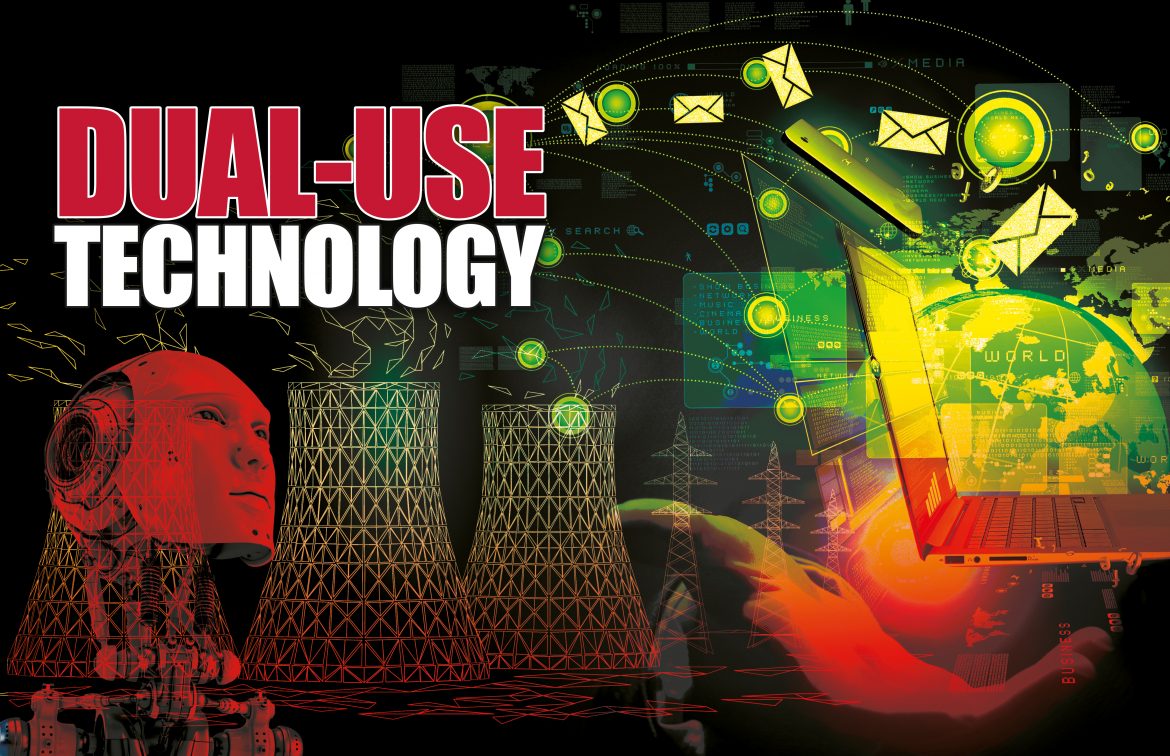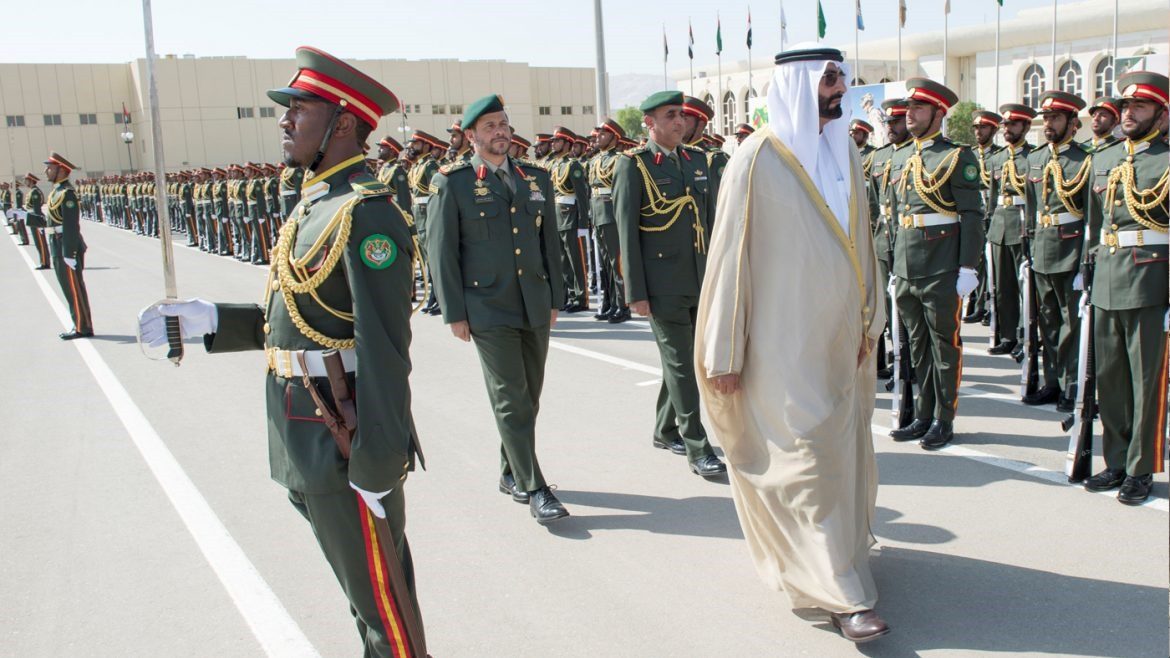Dual-use is a term used to describe materials and products that can be used in civilian or military fields, therefore their export is often subject to special laws and controls and may be prohibited to certain countries, and countries included in some black lists cannot obtain these dual-use materials or products.
Therefore, many countries have become more self-reliant in developing technologies used in the manufacture of non-conventional weapons, and the use of dual-use equipment, under the cover of scientific and peaceful activities. This enabled the proliferation of such weapons as well as their production programmes, which include the clandestine and illegal acquisition of materials that are dual-use in nature and are often imported under the cover of legitimate research and development projects, such as the production of vaccines, drugs and fertilizers, to circumvent international inspections. Both the civil and military fields include strong incentives for the development of new technologies, given that the alignment of military standards with civilian concerns leads to accelerated technical progress. Furthermore, innovations encouraged by military needs can develop without the natural impediments of the civilian market, because military institutions are among the main contributors to the funding of scientific research and development. For example, the development of military aviation technologies, armoured vehicles that withstand the harshness of the desert environment, and fast ships, occurred in military laboratories and were developed for war. However, they quickly spread and are used in civilian fields because When the military work ends, some manufacturers shift to adapting their production to civilian use. Furthermore, innovations first introduced for military work are not limited to the industry of heavy machinery but extend to medicine as well, as many therapeutic serums were developed in military laboratories. On the other hand, some technologies were developed for civilian use but were ultimately used for military use, such as iron mining techniques, initially developed and used to improve agricultural tools like ploughs, before they were widely used to make swords, shields, and weapons of war.
Another example is Ammonia, initially developed to enhance the potency of fertilizers and increase the yield of agricultural lands, before they were used to produce chemical weapons in World War I. During the Cold War era, Washington and Moscow spent a lot of money on the development of missile technologies that can launch spacecrafts for peaceful uses, such as remote sensing, communications, meteorology, and navigation, however, the same technologies were ultimately used to develop intercontinental ballistic missiles. For their part, countries that develop ballistic missiles can claim that their programs aim to develop missiles to launch satellites used for peaceful and scientific purposes. Furthermore, countries producing advanced night vision devices used in war prohibit the proliferation of their devices to prevent them from reaching enemy hands, however, these devices have many civilian uses, in the fields of photography, medicine, firefighting, and others.
Nuclear technology
Nuclear technology is considered the most concerning regional and international issue, as demands on it increase for various reasons, including the need for new and renewable sources of energy, however, many of the countries that went for the military nuclear option, or already possessed it, have since reversed their courses, such as South Africa, Brazil, and Argentina. Evidently, it is easy to evade international controls and make the transition process from civil to military uranium enrichment.
for example, the centrifuge can be used in the medical field or to manufacture enriched uranium for military purposes and graphite columns can be used to control nuclear reactors, or used in civilian fields. Similarly, Radiological Dispersal Devices (RDDs) or dirty bombs, are essentially radioactive nuclear materials that can be placed in conventional explosives, and the resulting explosion vaporizes the toxic isotopes and spreads radiation over large areas. Such bombs cause enormous psychological damage by exploiting the fear of invisible radiation, or an economic problem by making certain areas off-limits for a long time. Obtaining radioactive isotopes is relatively easy because of their widespread use in scientific and medical purposes, such as radiotherapy for cancer patients, or for industrial purposes, such as killing bacteria in food, sterilizing medical products, examining solder joints, and conducting research in physics and nuclear engineering.
Furthermore, the International Atomic Energy Agency announced that most countries in the world have the radioactive materials needed to make a dirty bomb, and lack sufficient means of control to prevent the theft of these materials.

Computer technologies
At the beginning of the second half of the 20th century, the military was the main supporter of research and development for the electronic industries. Some of the main forms of technical superiority in these areas were first developed for military systems, including high-speed computer hardware and networks, as scientists sought to increase the processing power of computer systems to develop weapons with massive destructive capabilities, particularly, nuclear weapons.
The first objective of supercomputer systems was to develop this type of weapon, to the extent that the United States classified computer systems as strategic products, imposing many restrictions on their export.
However, computers developed for civilian purposes have often become more effective compared to those developed for military use, and many companies are not interested in defence contracts, because these contracts are characterized by low-profit margins, slow decision-making processes, secure purchases, and difficulty in dealing with regulatory frameworks.
For example, the US has upgraded aircraft equipped with the Joint Surveillance Target Attack Radar System (JSTARS) to Block 20 level by replacing outdated computer systems with off-the-shelf components from the civilian market. The new design of the upgrade program features an integrated computer architecture and signal processor based on off-the-shelf components from the civilian market, which can be easily upgraded, allowing for the procurement of low-cost hardware and software that meets system requirements beyond the next twenty years.
One example of dual-use is computer simulations used by civil airlines and Airforces to train pilots. For the military, simulators not only reduce training costs but also allow for training in combat scenarios that are too dangerous to conduct in the field. This technology allows for simulations that include more than one aircraft or tank and comprehensively replicates engagement operations. It can also be used in the design and testing of new weapons, in addition, civilian companies use it to design electronic circuits, computers, communication devices, and even new cars and planes, before building a prototype.
Artificial Intelligence (AI)
Artificial intelligence is a branch of computer science concerned with the study and design of an intelligent algorism that understands its environment and makes decisions that increase its chances of achieving its objective.
It is the science and engineering of making smart machines that can correctly interpret external data, learn from that data and use it to achieve specific tasks and objectives, in a manner similar to simulating human mental capabilities and patterns, which are characterized by learning, response, and conclusion.
AI technology has been used in a wide range of civilian fields, including expert systems, automated control, internet search engines, natural language processing, voice recognition, image analysis, video games, and medical diagnostics.
Robots equipped with artificial intelligence technology can support production in factories, without the need for human intervention in manufacturing, packaging, and other processes. The military uses of artificial intelligence technology promise to provide great opportunities in the fields of improving target detection, discrimination, tracking and elimination capabilities. All of these technological developments will have a profound effect on the nature of war in the future after providing distinctive capabilities in terms of speed of data processing, automation of a combination of manned and unmanned weapon platforms and surveillance systems, and decision-making in command and control systems.
Digitisation
Digitisation constitutes a paradigm shift in information and communication systems, and it highlights the similarity between military and civilian networks. Civilian information systems are usually characterized by a high level of quality that prompts military institutions to use them. In the 1990s, the biggest shift towards digitisation occurred with the digital revolution, prompting military institutions to convert all their tools and devices to operate digitally. The trend of digitising the broadcast and analysis of information opens a new field, moving in several integrated directions, both civil and military. Digital data has become a necessary element in almost every weapon system, as the digital battle is considered a “smart” application of information technology, to achieve superiority on the battlefield, without the need to create new platforms for weapons. This provides the battlefield with a capacity similar to that of the internet after the digital technology of data began to expand gradually to include various military activities that depend on digital computers, in all fields, from analyzing and classifying information, to developing combat plans, communication, and so on.

Laser technology
Laser technology is used in many civilian applications, in the fields of medicine, communications, scientific and engineering research, as well as the electronic industries, accurate distance measuring devices, and welding solid materials.
On the other hand, military applications have witnessed a wide development that indicates moving in the same direction, but with more diversity. in this context, a notable phenomenon can be seen, with the gradual penetration of laser technology into the fields of weapons, systems or components that are relatively small in size. Modern wars have witnessed many uses of laser beams, whether to designate targets and direct projectiles towards them or to measure the distance of these targets and distinguish them through LADAR, in addition to the experiments conducted in the field of directed energy weapons on the use of the high power of laser beams to destroy ballistic missiles and drones.
The danger of laser beams does not lie in the difficulty of obstructing them, but rather in their ability to paralyze the effectiveness of various means of vision, whether with the naked eye or with optical devices and optical intensifiers, given that lasers can disable or destroy any sensitive optical part.
The US lead the way
The US’s Defense Advanced Research Projects Agency (DARPA) has been pioneering the field of dual-use technologies, such as advanced computer networking technologies, including the ARPANET, the predecessor to the Internet, and parallel processors of information. The US administration authorized the agency to spend large amounts of money, in the form of funds for the private sector, on researching these technologies.
Furthermore, the US National Weapons Laboratories began to encourage similar activities to advance the cooperation between the government and the industry, thus the US Los Alamos National Laboratory (the birthplace of the atomic bomb) announced that it would make the first commercial agreement of its kind, with the help of a private company, to improve the production of printed circuit boards. The laboratory also announced that it would lend X-ray technology, which had been developed for nuclear weapons research, to a company that manufactures mammography machines to diagnose breast cancer in women, and at that time the media announced, “that the defensive technology has turned to the war on breast cancer.”
Military requirements encouraged the rapid spread of new technologies in the US. For example, in 1937, two companies developed MARC computers for the US Navy and beginning in 1939, the Bell Laboratories worked on computers for the US Army’s artillery. Furthermore, in 1944, the US Army supported the “ENIAC” computer development program, the first-ever digital computer, at a university.
In addition, in the late 1950s, computer-aided design programs were developed for the Atlas intercontinental ballistic missile program. The years of World War II witnessed many innovations in many areas of civilian technology, some of which were based on pre-war research, but remained unfinished until Washington funded them to help the Allied forces.
Military specifications tolerance
Both military and civil technology require special specifications, as well as some common ones, and given that the technology that falls within this overlapping area is in more demand, it is usually characterized by a faster rate of development as it enjoys the benefit of both sectors, military and civil, while the specifications unique to each sector get less interest and therefore less support and progress.
The military sector can obtain many new capabilities from the civilian industrial sector, especially in the information and electronics sectors, where competition plays a major role in advancing research and development.
The elements of basic and applied research are the same, and the main difference is adding defence specifications, which adds to the cost.
Often, the military was not satisfied with the specifications of civilian technology and insisted on getting military specifications, which resulted in less utilization of civilian technology in military applications. However, recent decades have seen great developments in some civilian technologies, which made the military rethink its stand on military specifications and the feasibility of spending on developing technologies that meet these standards.
Therefore, taking advantage of civilian technology in military applications became a growing trend and now most modern technologies are used in both fields, which can be seen particularly in the field of information technology. However, the military’s increasing use of off-the-shelf civilian technologies in the field of information systems increases the risks of exposure to viruses, as well as the chances of using familiar systems with known vulnerabilities, which would justify the use of separate networks for the flow of highly sensitive information and key command and control communications, despite pressures for cost reduction.
In 1994, the Pentagon began amending the Military Specifications policy, so that it may only be used narrowly, effectively giving officials the authority to purchase civilian components, unless there was a strong reason to stick to military specifications. Thus, the US Department of Defense changed its procurement system, by moving away from preferring military specifications towards civilian specifications. To put things into perspective, when the US Air Force authorized the purchase of civilian components, the cost of the Joint Direct Attack Munition (JDAM) was half its former cost. The C-17 military transport aircraft program was on the verge of cancellation in 1993, but under the new system, it is meeting the requirements ahead of schedule and saving up to $5 billion through the use of civilian components.
In 1995, the US Congress authorized the implementation of five pilot programs, giving their managers complete authority over the use of civilian components and practices, and these five programs were important not only for the savings they could achieve but also because they could pioneer all purchases for the Ministry of Defense, given that the wider use of civilian components not only leads to cost reduction but leads to better products as well.
The five programs selected include, the JDAM bomb program, the Combined Arms Tactical Training Device, and the Aircraft Initial Training System, which all proved that the use of civilian products, leads to improvements in the development and delivery schedules at a lower cost. For years, the world’s armed forces have been using computers that have been subjected to severe testing conditions, capable of operating in temperatures below zero and above 170 degrees Celsius, and can withstand impacts of up to 30 pounds.
These devices have a strong external casing to maintain their internal components, which are fixed in a way that ensures that they do not move when subjected to shocks, but these requirements are associated with an increase in cost. However, since the late 1980s, the military started to ease these restrictions, especially after the wars in the Gulf and Afghanistan demonstrated the performance efficiency of computers designed for civilian uses, which prompted military officials to resort to civilian companies.
Dual-use technology control agreements
Dual-use technologies represent a major obstacle to arms control efforts, given that any strategy based on prohibiting access to dual-use products is impossible, however, dual-use technology itself is not the threat, thus prohibiting access to it is only done when a trend to misuse it emerges, or when the risk of potential misuse is high. Currently, there are 4 international control agreements for dual-use technology, which aim to maintain regional and global stability and security, and prevent extremist groups from accessing these technologies, and these agreements are:
• Wassenaar Arrangement (WA) on export controls of conventional weapons, technologies and dual-use goods: a Multilateral Export Control Regime (MECR) through an international body Established in 1996, implemented by 42 countries which monitor their national export operations, however, this agreement is not a legally binding treaty for members who exchange information on conventional arms transfers to non-member states every 6 months. These weapons include tanks, armoured vehicles, large-calibre artillery, fixed-wing military aircraft, military helicopters, warships, missile systems, and light and small arms.
• The Nuclear Suppliers Group (NSG) for nuclear technologies control: This group includes several nuclear materials exporting countries, and aims to prevent nuclear proliferation. It was founded in 1975 with only 7 countries, but now it includes 48 countries, and its objectives align with every treaty and agreement in this regard.
• The Australia Group (AG) for the control of chemical and biological technologies used in weapons: It is an informal group, formed by 15 countries in 1985, but now it includes 43 countries, and aims to reduce the risks of the spread of chemical and biological weapons, and holds an annual meeting in Paris.
• Missile Technology Control Regime (MTCR): This system was developed in 1987 by the G-7 industrialized countries, and now 35 countries participate in it, to set the criteria for the non-proliferation of platforms capable of carrying weapons of mass destruction (except for manned aircraft), with a focus on missiles and drones that carry more than 500 kg (1,100 lb) and have a range of more than 300 km (190 miles).
In addition to these agreements, Washington imposes economic sanctions on countries that export dual-use materials for civilian and military purposes, or sensitive technologies that can be used in the manufacture of prohibited weapons, the US also sanctions the countries that import these materials and products, to prevent them from using them to make weapons. The US accuses Russia and China of selling sensitive technologies that can be used for civilian and military purposes to countries such as Iran and North Korea, which Washington considers a threat in terms of the spread of non-conventional weapons. On April 28, 2004, the UN Security Council unanimously decided that all states should refrain from providing any form of support to non-state actors trying to develop nuclear, chemical or biological weapons and their means of delivery, possession, manufacture, transfer or use, and issued Resolution No. 1540.
Conclusion
Countries have been spending generously throughout history, on the development of technologies required for military use, whether this is of importance to their national security, or to achieve a large return from marketing these technologies in the arms market. Therefore, the development of these technologies was not affected much by natural market constraints, or economic conditions, compared to technologies that are developed specifically for civilian uses, which often receive less funding. It was only natural for the civilian sector to attempt to take advantage of military technologies, as was the case with aviation, radios, radars, computers, and space, as both sectors realized that whenever military and civilian specifications align, technical progress accelerates, and that this is the most cost-effective method.
« By: Major General Dr Ali Muhammad Ali Rajab (military researcher and strategic expert)




















